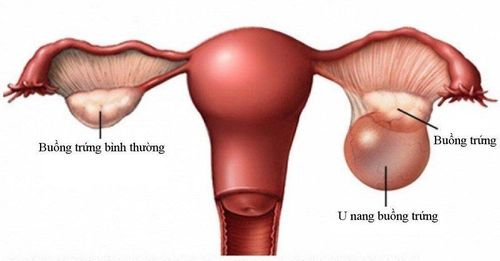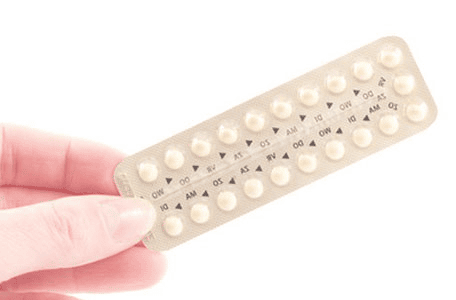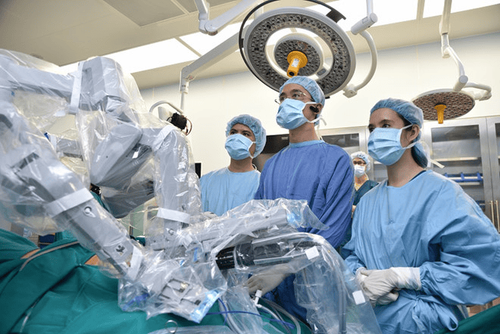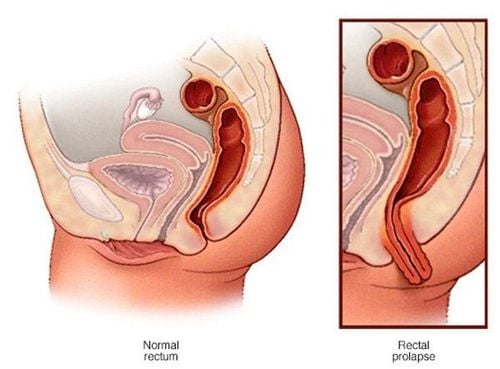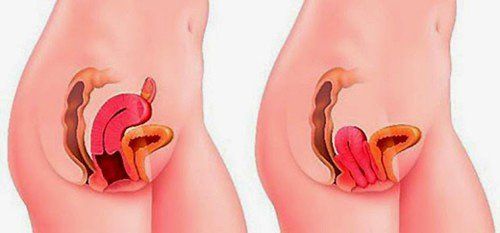This is an automatically translated article.
The article was professionally consulted by Doctor Nguyen Chi Quang, Department of Obstetrics and Gynecology - Department of Obstetrics and Gynecology - Vinmec Central Park International General Hospital.Women of reproductive age and entering menopause are more likely to have genital prolapse. The disease manifests as urinary disorders, constipation, pain during intercourse and many other problems. Treatment methods also vary depending on the severity of the disease.
1. What is genital prolapse?
Genital prolapse is a phenomenon in which the uterus descends into the vulva, accompanied by prolapse of the anterior vaginal wall and bladder, or the posterior wall of the vagina and rectum.Genital prolapse is a common disease, affecting 1/8 of women aged 40 - 50, the degree of prolapse can vary. The disease is not life-threatening but greatly affects the patient's life and work.
Bladder prolapse (bladder hernia), urinary tract prolapse (urinary hernia), intestinal prolapse (intestinal hernia) rectal prolapse are common cases.
2. Classification of genital prolapse
2.1 Classical classification Grade 1:Anterior vaginal prolapse (combined with bladder prolapse) Posterior wall prolapse (combined with rectal prolapse) The cervix descends more than 1 cm from the hymen margin. Grade 2:
Anterior vaginal prolapse (combined with bladder prolapse) Posterior wall prolapse (combined with rectal prolapse) The cervix begins to show in the vagina Grade 3:
Anterior vaginal prolapse (combined with bladder prolapse) Prolapse posterior wall (combined with rectal prolapse) Uterus protrudes out of the vagina more than 1 cm from the hymen edge Grade 4:
Entire uterus, bladder completely prolapse outside the vulva
2.2 Classification according to the POP system -Q
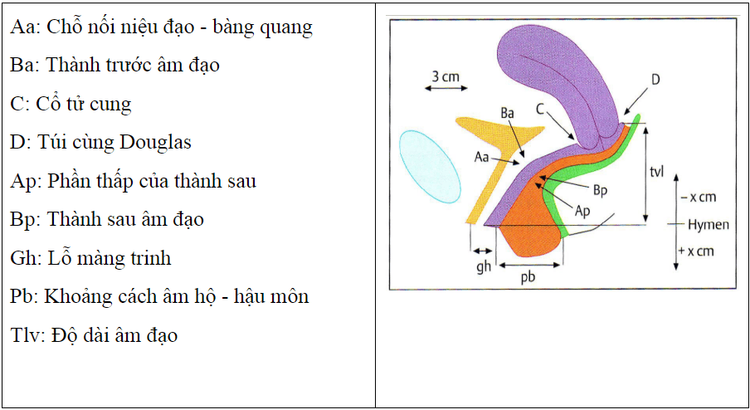
Grade 0: No genital prolapse. Aa, Ap, Ba, Bp 3cm above the hymen. Score C or D: (Tlv - 2) < C, D <= Tlv.
Grade 1: Having B > 1cm above hymen
Grade 2: Having B about 1cm above or below hymen
Grade 3: Having B > 1cm below hymen to less than about (Tlv - 2cm)
Grade 4: Prolapse total genitalia, B >= (Tlv - 2cm)
3. Symptoms of genital prolapse
Rectal prolapse progresses quite slowly, from 5 to 20 years. How fast or slow progress depends on the number of reproductions, working status and health of the woman.3.1 Functional symptoms There are 5 groups of symptoms that often appear in women with genital prolapse as follows:
Lower urinary tract: Patients may have manifestations such as urinary incontinence, increased frequency of urination, flow weak urine or prolonged urination, hesitancy, feeling of incomplete urination, sometimes having to use hands to push the prolapse before and after urinating. Pelvic organ prolapse: Vaginal bulging sensation, pelvic/vaginal pressure or heaviness, palpable bulge. Sexual disorders: Painful intercourse, feeling of obstruction, wide vagina. anorectal disorders: Constipation, having to strain to pass stool, feeling that stools are not completely eliminated, bleeding or mucus in the rectum. There is pain in the lower urinary tract and other pelvic organs: Pain in the bladder, urethra, vulva, vagina, perineum, neuralgia. Pain may or may not be cyclical. 3.2 Physical symptoms Examination revealed prolapse in the lower half of the vagina or protrusion in the vulva. The exposed prolapsed mass may be keratinized, ulcerated by rubbing or superinfection.

Da Vinci robot made in the USA is an advanced, sophisticated, modern robot with 4 arms that almost perfectly simulate human hand movements, meeting the needs of surgery with requirements. tallest. Thanks to this feature, surgical robots can penetrate narrow, deep and difficult to reach locations, solving the limitations of classical open and laparoscopic surgery. With outstanding advantages: Safety, minimizing the risk of complications and surgical infection, pain relief, less blood loss, quick recovery, ensuring aesthetics, the robot can be used for most surgeries. cases must be treated with endoscopic methods especially in cancer treatment.
Before becoming a Doctor of Obstetrics and Gynecology at Vinmec Central Park International General Hospital, Dr. Nguyen Chi Quang used to work at Tu Du Hospital and University Hospital of Medicine and Pharmacy in Ho Chi Minh City. Dr. Quang has many years of deep professional experience and strength in the treatment of obstetric and gynecological diseases such as:
Laparoscopic surgery Uterine fibroids Laparoscopic surgery for ovarian tumors Laparoscopic surgery for genital prolapse
Please dial HOTLINE for more information or register for an appointment HERE. Download MyVinmec app to make appointments faster and to manage your bookings easily.





